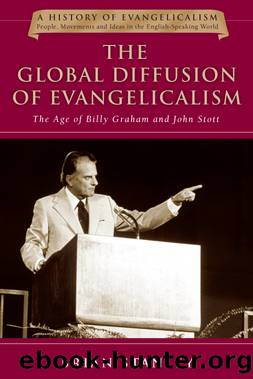The Global Diffusion of Evangelicalism by Stanley Brian;

Author:Stanley, Brian; [Stanley, Brian]
Language: eng
Format: epub
ISBN: 9780830895540
Publisher: InterVarsity Press
Published: 2013-05-14T00:00:00+00:00
The Lausanne movement after 1974
The Lausanne movement, which has continued into the twenty-first century, has thus had to negotiate a winding path between divergent interpretations of what the true message of the 1974 congress was. There is evidence that Billy Graham lost interest in the Lausanne movement after the Mexico City meeting, feeling that the resources of the Billy Graham Evangelistic Association would be more productively employed in funding conferences specifically for practising evangelists.[534] In contrast, some on the left wing of evangelicalism felt that the movement had failed to maintain the momentum of gospel radicalism generated in 1974. In their view, at the Lausanne consultÂation held in Pattaya, Thailand, in June 1980 the holistic missionary vision of Lausanne was overwhelmed by a resurgent strategic pragmatism focused on the concept of unreached peoples.[535] In response nearly one-third of the delegates signed a statement of concerns on the future of the LCWE drawn up by Orlando Costas and six others.[536] The statement complained that the LCWE âdoes not seem to have been seriously concerned with the social, political and economic issues in many parts of the world that are a great stumbling block to the proclamation of the gospelâ, and called for the LCWE to convene a world congress on social responsibility and its implications for evangelization. Costas found the response to the statement from the leadership of the LCWE disappointing, feeling that only John Stott took its concerns seriously.[537] No world congress on social responsibility was forthcoming, although LCWE was already committed to holding a consultation on evangelism and Christian social responsibility in June 1982. It was at this significant event, held in Grand Rapids, that Stott composed what has since become a well-known definition of the relationship between Christian social action and evangelism as being like âthe two blades of a pair of scissors or the two wings of a birdâ.[538] Nonetheless, in response to what they saw as Pattayaâs apparent indifference to the concerns of the radical evangelicals, Costas and twenty-four other evangelical theologians from the Latin American Theological Fraternity, Partnership in Mission-Asia, and the Africa Theological Fellowship felt it necessary in March 1982 to set up their own organization, known originally as the International Fellowship of Evangelical Mission Theologians (from the Two-Thirds World) (INFEMIT).[539]
The Lausanne movementâs second full congress, held in Manila in 1989, marked something of a resurgence of a holistic emphasis. Its documentation included a powerful paper on âReaching the Oppressedâ written by Caesar Molebatsi, a black South African who had been prominent in the gathering campaign against the apartheid regime.[540] The Manila Congress produced a series of twenty-one affirmations that built on the statements of the Lausanne Covenant. They included both an explicit commitment to denounce injustice in the name of Godâs kingdom of justice and peace (no. 9) and an insistence on the urgency of world evangelization and the possibility of reaching unreached peoples (no. 19). The last of the twenty-one affirmed, using the words of the Lausanne Covenant, that âGod is calling the whole church to take the whole gospel to the whole worldâ.
Download
This site does not store any files on its server. We only index and link to content provided by other sites. Please contact the content providers to delete copyright contents if any and email us, we'll remove relevant links or contents immediately.
| Buddhism | Christianity |
| Ethnic & Tribal | General |
| Hinduism | Islam |
| Judaism | New Age, Mythology & Occult |
| Religion, Politics & State |
Cecilia; Or, Memoirs of an Heiress — Volume 1 by Fanny Burney(31341)
Cecilia; Or, Memoirs of an Heiress — Volume 3 by Fanny Burney(30938)
Cecilia; Or, Memoirs of an Heiress — Volume 2 by Fanny Burney(30894)
The Secret History by Donna Tartt(16643)
Sapiens: A Brief History of Humankind by Yuval Noah Harari(13067)
Leonardo da Vinci by Walter Isaacson(11912)
The Radium Girls by Kate Moore(10914)
Sapiens by Yuval Noah Harari(4546)
The Wind in My Hair by Masih Alinejad(4427)
How Democracies Die by Steven Levitsky & Daniel Ziblatt(4407)
Homo Deus: A Brief History of Tomorrow by Yuval Noah Harari(4287)
Endurance: Shackleton's Incredible Voyage by Alfred Lansing(3851)
The Silk Roads by Peter Frankopan(3768)
Man's Search for Meaning by Viktor Frankl(3644)
Millionaire: The Philanderer, Gambler, and Duelist Who Invented Modern Finance by Janet Gleeson(3573)
The Rape of Nanking by Iris Chang(3520)
Hitler in Los Angeles by Steven J. Ross(3442)
The Motorcycle Diaries by Ernesto Che Guevara(3340)
Joan of Arc by Mary Gordon(3262)
